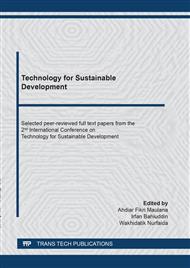[1]
S. Wang, Y. Zhang, Y. Wang, J. Jiao, Z. Ji, and M. Han, Post-seismic deformation mechanism of the July 2015 MW 6.5 Pishan earthquake revealed by Sentinel-1A InSAR observation,, Scientific Reports, vol. 10, no. 1, p.18536, 2020/10/28 2020,.
DOI: 10.1038/s41598-020-75278-0
Google Scholar
[2]
T. Sun et al., Prevalence of viscoelastic relaxation after the 2011 Tohoku-oki earthquake,, Nature, Letter vol. 514, no. 7520, pp.84-87, 2014,.
DOI: 10.1038/nature13778
Google Scholar
[3]
H. Panuntun, S. Miyazaki, Y. Fukuda, and Y. Orihara, Probing the Poisson's ratio of poroelastic rebound following the 2011 Mw 9.0 Tohoku earthquake,, Geophysical Journal International, vol. 215, no. 3, pp.2206-2221, 2018,.
DOI: 10.1093/gji/ggy403
Google Scholar
[4]
B. M. K. d. G. Pusat Gempa bumi dan Tsunami. Katalog Gempa bumi Signifikan dan Merusak Tahun 1821 - 2018 (In Indonesian), Jakarta, 2019, p.292.
DOI: 10.36232/jurnalbiolearning.v7i2.517
Google Scholar
[5]
H. Saputra, W. Wahyudi, I. Suardi, A. Anggraini, and W. Suryanto, The waveform inversion of mainshock and aftershock data of the 2006 M6.3 Yogyakarta earthquake,, Geoscience Letters, vol. 8, no. 1, p.9, 2021/03/13 2021,.
DOI: 10.1186/s40562-021-00176-w
Google Scholar
[6]
D. Massonnet et al., The displacement field of the Landers earthquake mapped by radar interferometry,, Nature, vol. 364, no. 6433, pp.138-142, 1993/07/01 1993,.
DOI: 10.1038/364138a0
Google Scholar
[7]
H. Z. Abidin, H. Andreas, I. Meilano, M. Gamal, I. Gumilar, and C. Abdullah, Deformasi Koseismik dan Pascaseismik Gempa Yogyakarta 2006 dari Hasil Survei GPS,, Indonesian Journal on Geoscience, vol. 4, 12/28 2009,.
DOI: 10.17014/ijog.v4i4.87
Google Scholar
[8]
N. Widjajanti et al., Present-day crustal deformation revealed active tectonics in Yogyakarta, Indonesia inferred from GPS observations,, Geodesy and Geodynamics, vol. 11, no. 2, pp.135-142, 2020/03/01/ 2020, doi: https://doi.org/10.1016/j.geog.2020.02.001.
DOI: 10.1016/j.geog.2020.02.001
Google Scholar
[9]
M. Lazecký et al., LiCSAR: An Automatic InSAR Tool for Measuring and Monitoring Tectonic and Volcanic Activity,, Remote Sensing, vol. 12, no. 15, 2020,.
DOI: 10.20944/preprints202005.0520.v1
Google Scholar
[10]
C. Yu, Z. Li, N. T. Penna, and P. Crippa, Generic Atmospheric Correction Model for Interferometric Synthetic Aperture Radar Observations,, Journal of Geophysical Research: Solid Earth, https://doi.org/10.1029/2017JB015305 vol. 123, no. 10, pp.9202-9222, 2018/10/01 2018, doi: https://doi.org/10.1029/2017JB015305.
DOI: 10.1029/2017jb015305
Google Scholar
[11]
Y. Morishita, M. Lazecky, T. J. Wright, J. R. Weiss, J. R. Elliott, and A. Hooper, LiCSBAS: An Open-Source InSAR Time Series Analysis Package Integrated with the LiCSAR Automated Sentinel-1 InSAR Processor,, Remote Sensing, vol. 12, no. 3, p.424, 2020. [Online]. Available: https://www.mdpi.com/2072-4292/12/3/424.
DOI: 10.3390/rs12030424
Google Scholar
[12]
P. Wessel et al., The Generic Mapping Tools Version 6,, Geochemistry, Geophysics, Geosystems, vol. 20, no. 11, pp.5556-5564, 2019/11/01 2019,.
DOI: 10.1029/2019gc008515
Google Scholar
[13]
M.-P. Doin et al., Presentation of the small baseline NSBAS processing chain on a case example: The Etna deformation monitoring from 2003 to 2010 using Envisat data,, in Fringe 2011 ESA Conference, Frascati, Italy, (2011).
Google Scholar
[14]
A. Koulali et al., The kinematics of crustal deformation in Java from GPS observations: Implications for fault slip partitioning,, Earth and Planetary Science Letters, vol. 458, pp.69-79, 1/15/ 2017, doi: http://dx.doi.org/10.1016/j.epsl.2016.10.039.
DOI: 10.1016/j.epsl.2016.10.039
Google Scholar
[15]
A. Sutiono, B. Prastistho, C. Prasetyadi, and Supartoyo, Opak fault: a comparative review,, IOP Conference Series: Earth and Environmental Science, vol. 212, p.012049, 2018/12/31 2018,.
DOI: 10.1088/1755-1315/212/1/012049
Google Scholar


